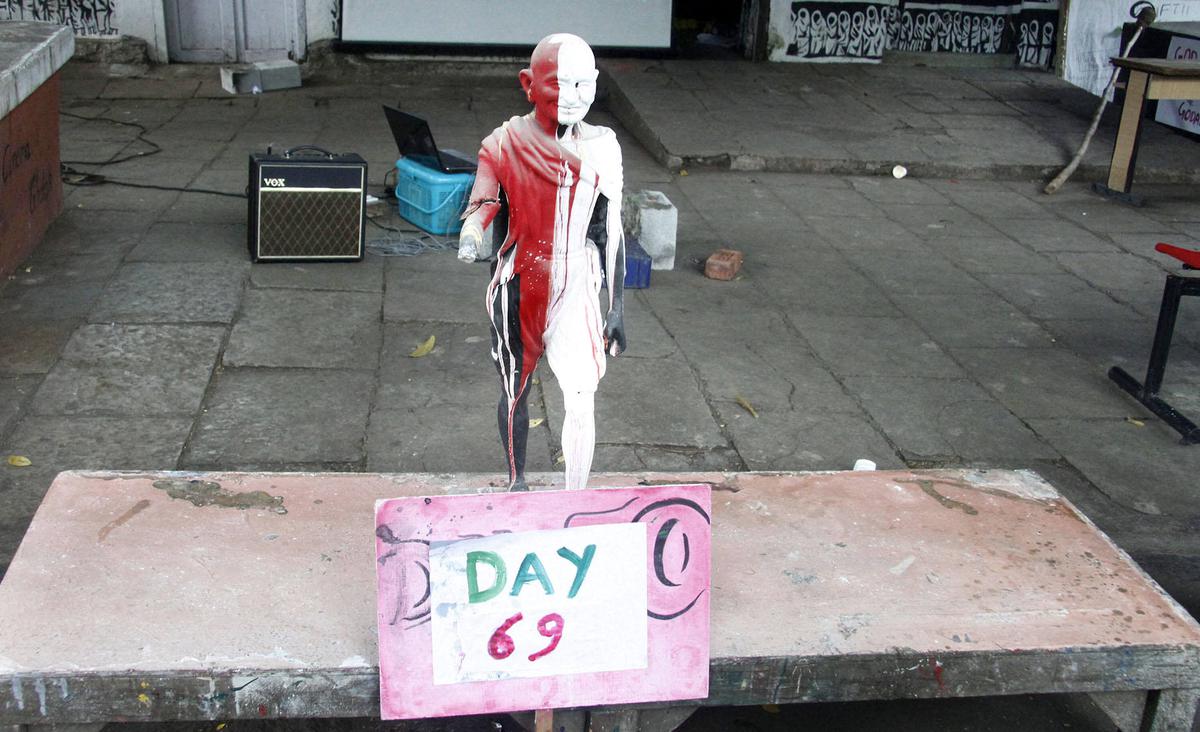
The author does not treat the FTII strike as a stand-alone event
| Photo Credit: PTI
I read Ashish Rajadhyaksha’s John-Ghatak-Tarkovsky quickly after Saeed Mirza’s I Know the Psychology of Rats (Tulika, 2023). Both books belong to a lineage of contemplating film education in the country, its roadblocks, and the perils of a filmmaker in contemporary India. How do filmmakers assert their rights as citizens? Should a filmmaker be necessarily politically engaged? How does cinema or campus relate to the nation? Mirza has written a thoughtful foreword and appears on several occasions in Rajadhyaksha’s book. They perhaps belong to the same gharana of ideological alignment, though the unravelling of the raga is done differently. Mirza reflects on his friendship and memories of fellow filmmaker and collaborator, Kundan Shah, while Rajadhyaksha attempts to enshrine the events of 2015 that led to the students’ strike at The Film and Television Institute of India (FTII) against the backdrop of the larger nation vis-à-vis the newly-elected political dispensation that governed the country and its ideological moorings. The campus and its students thus became a microcosm of the nation and emblematic of what Rajadhyaksha imaginatively calls the state’s ‘distrust of cinema.’
ALSO READ All you need to know about the FTII students strike
Beyond the campus
Rajadhyaksha’s quest, however, is not merely empirical. He creates a discourse around the students’ strike by laying bare a chronology of events that transpired before, during and after the strike, while reflecting and simultaneously trying to link the happenings on campus with changes in the aesthetics and technology of film in post liberalisation India. The book can also be read as a parallel history of FTII as a famed film education institute, the strikes that happened in the past, the people involved and their bearings on film education. To such an extent that at one point during the strike, a faculty member asks the students if the strike is taking them away from film education. Rajadhyaksha rightfully observes that the strike of 2015 engaged with issues that were larger than the campus, while strikes that happened in the past focused primarily on campus-related issues. In 2015, it was for the first time that the students decided to take the strike beyond the confines of the FTII by travelling to other campuses in the country, leading to nationwide protests, demonstrations and two important protest marches in Delhi. It, therefore, consciously attained a political character by taking on issues of larger interest to the country.
A student falls asleep as the deadlock in negotiations between protesting FTII students and the I&B Ministry continued in 2015
| Photo Credit:
Arunangsu Roy Chowdhury
Environment of intolerance
To reproduce or recreate this time, Rajadhyaksha relies on the accounts of dissenting students such as Nachi, Vikas, Kislay, Prateek, among several others quoted in the book. Many of these students are now recognisable names in the indie cinema circuit. An important moment in the recent history of dissent in the nation is thus evoked through the participation of its makers. Rajadhyaksha listens, records, and analyses thereby giving film history-based writing, or film writing in general, a push in a new, radical direction: to engage with the pedagogy and practice of film education, which remains an underexplored domain in writing on cinema in India.
The strike also offers an opportunity for the author to raise other pressing questions: the shift from celluloid to digital, spawning of new video cultures using the mobile phone camera, cinephobia of the state, censorship laws, and the elitism of film education. While the 2015 strike is the genesis of the book, the author seizes this moment to reflect on an array of associated events in and around the campus, including the rise of conservatism in Pune and the country, and what that might mean for the arts and the humanities in general. The author does not treat the FTII strike as a stand-alone event, but contextualises it in an environment of hate and intolerance.
Cinema and activism
During his last visit to FTII in 1974, filmmaker Ritwik Ghatak did not want to teach how to make films. Rajadhyaksha writes, “The actual, infinitely more urgent problem lay elsewhere: it was how to become filmmakers — how to become Eisenstein, approximate to a responsibility, a vocation even.”

A placard placed near Gandhi’s statue at FTII
| Photo Credit:
MANDAR TANNU
In many ways, how to become a filmmaker also seems to be the guiding enquiry for Rajadhyaksha’s book and the role that spaces such as FTII play in such a process. The book records the stories of several who went on to chart their own path after FTII, refusing state or private patronage, making cinema through collectives, embracing documentary for artistic expression and activism. Many of these individuals also constitute what is largely identified as the avant-garde in Indian filmmaking by adding, remaking, and reinventing cinema in many ways.
Rajadhyaksha’s John-Ghatak-Tarkovsky will be hailed as an important intervention in rethinking film-based scholarship in India and the directions it could take by consciously acquiring a more public-facing persona. It will also be remembered as an important contribution in writing a contemporary history of dissent in the country.
The writer teaches literary and cultural studies at FLAME University, Pune.
Stay connected with us on social media platform for instant update click here to join our Twitter, & Facebook
We are now on Telegram. Click here to join our channel (@TechiUpdate) and stay updated with the latest Technology headlines.
For all the latest Entertainment News Click Here
For the latest news and updates, follow us on Google News.
